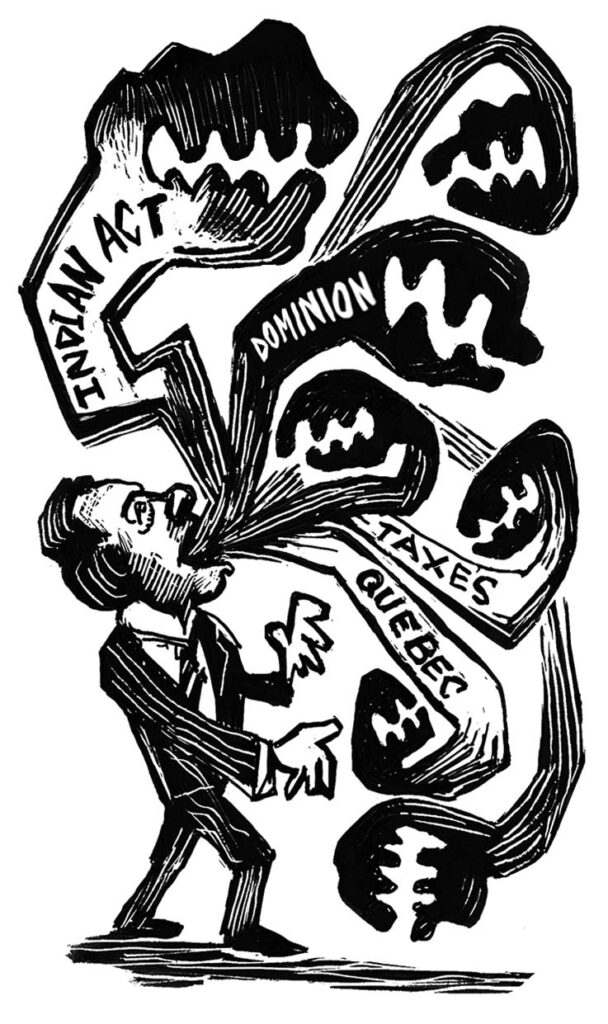Ernest Renan, the nineteenth-century French intellectual, is largely remembered for having written that “forgetting is a crucial factor in the creation of a nation.” What is less often cited is his reasoning: “Indeed, historical enquiry brings to light deeds of violence which took place at the origin of all political formations, even of those whose consequences have been altogether beneficial. Unity is always effected by means of brutality.”
I recalled Renan’s comment while reading Anne Trépanier’s book on the pre-Confederation press. I had thought that the current vilification of Sir John A. Macdonald, which has led to his name being taken off buildings and his statues being taken down, was the result of relatively recent revelations, like those in James Daschuk’s Clearing the Plains, from 2013, about his government’s treatment of First Nations. I had assumed that their fate was a matter of little awareness or concern generations ago. And I had thought John Wilson Bengough, the pioneering political cartoonist, was just making gentle fun of Macdonald in those iconic images of his.
As a result, I was astonished to discover that Bengough had illustrated a cover of Grip magazine in 1888 that shows the prime minister exchanging bags of money with a cigar-smoking capitalist as an Indigenous family begs for food next to them, with a sign near their teepee reading, “STARVED by a ‘Christian’ Gov’t.” Another cartoon for Grip, which Bengough drew eight years earlier, casts Macdonald as an auctioneer in England, with a First Nations woman standing on a block labelled “Governm’t Policy.” Here Macdonald’s crowded bill of sale proclaims, in part, “To be SOLD! The People of the North West.” Underneath the drawing, a caption reads, “Startling Affair in London! A Promising Young Woman Offered for Sale to the Highest Bidder!!”

Public angst and the pre-Confederation press.
Silas Kaufman
That J. W. Bengough had a sharper, harsher view of Macdonald and a better understanding of his now-reviled policies than his best-known caricatures would suggest was only one of the surprises in Trépanier’s informative look at historical Canadian newspapers. Indeed, she uncovers in De l’hydre au castor (From the Hydra to the beaver) a wide range of fears and concerns surrounding Confederation.
A Canadian studies professor at Carleton University, Trépanier notes how the historical record tends to ignore the political engagement of nineteenth-century First Nations: “Figuring among the great excluded of the Canadian Confederation in 1867, Indigenous people paid a price for the profoundly racist policies introduced by Confederation. Nevertheless, they were not passive witnesses.” In describing lengthy debates and proposals before and after the British North America Act of 1867, she demonstrates how tribal leaders had as sophisticated an understanding of the stakes involved as did the politicians in the Maritimes: “In both cases, emancipation and Confederation, it was a question of choosing citizenship in a new country and concluding a pact with a political community larger than any of them could have imagined until then.”
The prospect of Confederation raised numerous concerns for its constituent parts: “Could one become Canadian without losing their identity? Who will be the first Canadians of Confederation? Who will be obliged to sign the agreement, who will be excluded?” Canadians asked themselves such questions while wrestling with other, more existential ones: What would their links with Great Britain be? How could they unite French Canadians and English Canadians? And how would they live beside their American neighbours?
Among the complications of political life during the period was the transformation of a number of politicians from rebels to reformers, contestataires to conservatives. The classic example is George-Étienne Cartier, who had been a militant Patriote in the 1830s, before becoming a lawyer for the Grand Trunk Railway, an influential Conservative, and ultimately Macdonald’s right-hand man. Like Cartier, the former republican idealists Denis-Benjamin Viger, Étienne Parent, and Louis-Hippolyte La Fontaine became allies of the British Crown and beneficiaries of favouritism. Cartoonists took note: Cartier and Viger were attacked as vire‑capots (turncoat), for example, alongside Hector-Louis Langevin.
In 1854, eleven years after the publication of Charles Dickens’s A Christmas Carol, the magazine Le Scorpion ran a parody. Three ghosts appear before the governor: the first insists that he do away with seigneurial rights, the second that he abolish the clergy reserves, and the third that he support annexation by the United States. Shuddering in fear, the governor agrees. In real life, Lord Elgin, the governor general of the Province of Canada, enacted two of these policies. Trépanier doesn’t mention it, but it is worth noting that, as governor general of British North America several years earlier, Lord Durham had recommended measures that would abolish the use of French and assimilate French Canadians. He is still often discussed in Quebec, while Lord Elgin, who would eventually reintroduce bilingualism, is all but forgotten. Bad news resonates; good news vanishes.
Cartoonists and satirists played on fears that Confederation might destroy the economies and self-sufficiency of the smaller colonies. Thus the concept was drawn in Quebec as a multi-headed creature, each head threatening the lamb that was French Canada. Similarly, the Liverpool Transcript in Nova Scotia described the plans that had emerged from the Quebec Conference of 1864 as an octopus, able to seize its prey with its eight arms and, when attacked, escape into the darkness created by its ink. Ten years later, a multi-headed dragon represented “The Election Monster” in the Canadian Illustrated News.
In studying the public anxieties captured by cartoonists and satirists, Trépanier set out to explore “in all their relief and contrast, the opinions, the fears and the dreams that the projects of Confederation fed in the societies of British North America.” She found discussions of gains and losses, virtue and necessity, conservation and calculated risk. And with her book, she has shown how some of the “forgotten” parts of Canadian history — like brutal policies toward Indigenous people — were once truths lying in plain sight.
Graham Fraser is the author of Sorry, I Don’t Speak French and other books.

